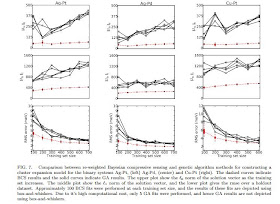Is this another aha! moment ? [1,2] I am not sure but it sure sounds like it. If you recall, I mentioned how slow some of the current compressive sensing reconstructions could be. We also mentioned pathways on how they could go faster. Sometimes it is really a question of context, in some cases, CS reconstructions are sometimes orders of magnitude faster than other traditional computation. Here, the L_1 solvers are pitted against "traditional" genetic algorithms. Excerpted from the following intriguing paper (see below) here is what we can read:
Another key feature of BCS is the e fficiency of the algorithm. For the three systems discussed here BCS fits were constructed in a fraction of the time needed for the GA. BCS required on the order of minutes to construct 100 fi ts, whereas the GA needed 24 hours for a single fit.
This is an intriguing paper for different reasons. One of them is that it is a condensed matter physics dealing with crystal structures and attendant network effects: AMP and related Belief Propagation reconstruction algorithms are in fact coming from that field. The second reason has to do with the fact that solving the phase transition problem for different alloys has a tremendous industrial applications [3]. If CS reconstruction solvers can be found to be expanding this area, CS will have a major impact without necessarily being an implementation of a sensor. I also like the fact that on a meta-level, compressive sensing is able to seek a good solution out of an exponentially large set, I guess with the thought that only a few configurations, out of all this space, are worthy [3], I'll come back to that later.
Here is the paper: Cluster expansion made easy with Bayesian compressive sensing by Lance J Nelson, Vidvuds Ozolins, Shane Reese, Fei Zhou, Gus L. W. Hart
Long-standing challenges in cluster expansion (CE) construction include choosing how to truncate the expansion and which crystal structures to use for training. Compressive sensing (CS), which is emerging as a powerful tool for model construction in physics, provides a mathematically rigorous framework for addressing these challenges. A recently-developed Bayesian implementation of CS (BCS) provides a parameterless framework, a vast speed up over current CE construction techniques, and error estimates on model coefficients. Here, we demonstrate the use of BCS to build cluster expansion models for several binary alloy systems. The speed of the method and the accuracy of the resulting fits are shown to be far superior than state-of-the-art evolutionary methods for all alloy systems shown. When combined with high throughput first-principles frameworks, the implications of BCS are that hundreds of lattice models can be automatically constructed, paving the way to high throughput thermodynamic modeling of alloys.From the conclusion:
From a broader perspective, the CS paradigm is poised to have a big impact on computational physics problems of all types. The CS-paradigm is well suited to tackle any highly-underdetermined linear problem: Ax = b where x is known to be sparse. One possible application is the expansion of high-throughput databases to include lattice models. This approach relies heavily on being able to automatically perform first-principles calculations, and has hitherto not involved using the database information to build materials models. This is mostly due to the high human time cost required to construct such models.However, the hands-o ff nature of BCS-based CE models will allow materials models to be added to the high throughput scope of work. In addition to vast amounts of first-principles data, soon high-throughput databases will include accurate lattice models for a diverse array of materials.I note from Gus Hart's page:
Alloy modeling in my group utilizes HTCMS and cluster expansion. CE-flash: An automatic framework combined with a Bayesian-inference-based compressive sensing algorithm for model building has made it possible to generate alloy models at an unprecedented rate and without any human interaction.....
We are looking for postdocs and and Ph.D. students.
[2] Catching an aha moment with compressive sensing
[3] The high-throughput highway to computational materials design Stefano Curtarolo, Gus L. W. Hart,Marco Buongiorno Nardelli, Natalio Mingo, Stefano Sanvito and Ohad Levy

No comments:
Post a Comment